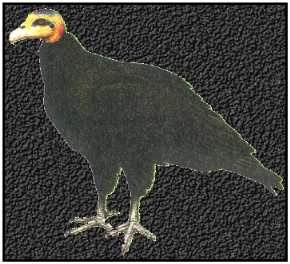Greater Yellow-HeadedOrder: Falconiformes. Family: Cathartidae. (New World vulture). Scientific Name: Cathartes melambrotus. The official 'coming out' of this bird was only in 1964; it was at this time that it received its official description based upon a specimen located in Kartabo, Guyana. The new vulture had been known to ornithologists for some years and was in museums worldwide, but it was initially confused with Cathartes burrovianus, a bird that is now known as the lesser Yellow-Headed Vulture. Common Names: Greater Yellow-headed Vulture. Conservation Status: Rare. Rescue & Recovery: None. Because this bird was recognised as a separate species only in relatively recent times we know very little about it, the numbers of birds, and how they are fairing in the never ending fight for survival. Geographical Range: Several scattered regions of South America reaching down to northern Brazil. Habitat: Lowland forests.
Greater Yellow-Headed VulturePhysical Characteristics: Adults have black plumage which sometimes displays a green or purple sheen. The head varies from yellow to orange and has a deep-blue crown with a blue spot in front of the red eyes. A pale bill and black feet complete the look. To date no voice has been recorded. Size is the easiest way to distinguish this bird from the (Lesser) Yellow-headed Vulture, with the Greater Yellow-headed Vulture being larger. Food: Exclusively a carrion feeder. Reproduction: Unknown.
|

